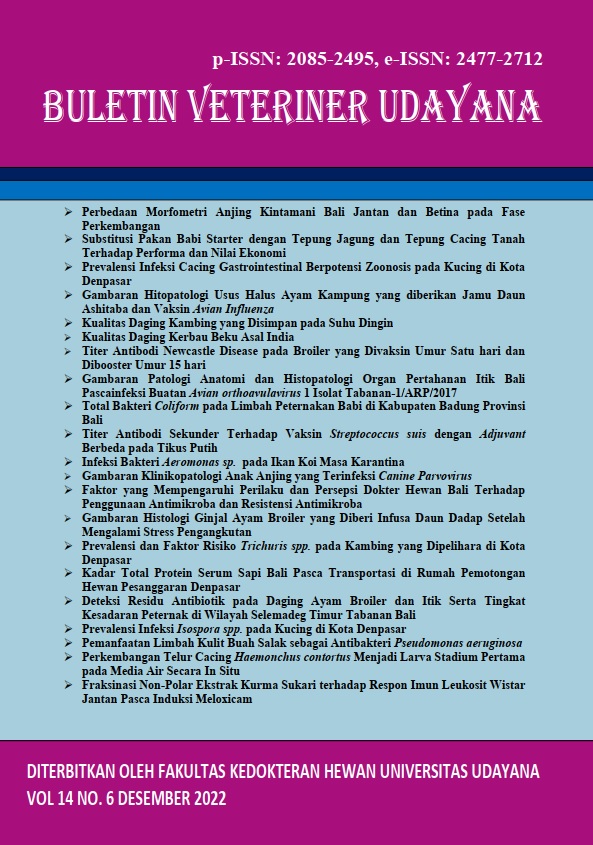DETECTION OF ANTIBIOTIC RESIDUALS IN BROILER CHICKEN AND DUCKS AND LEVEL OF FARMERS AWARENESS IN SELEMADEG TIMUR TABANAN OF BALI
Abstract
Public consumption of chicken meat, especially broiler and duck, continues to increase. Various efforts have been taken by farmers to increase their production by increasing the quantity of their livestock and improving livestock management. The government has banned the use of antibiotics under Law no. 41 of 2014. The existence of this law needs to be evaluated on livestock products produced. This study aims to determine the presence of antibiotic residues and also to determine the level of awareness of farmers to antibiotic residues in broiler chicken and duck meat in the Selemadeg Timur Tabanan of ??Bali. This research is a descriptive study by detecting samples of chicken and duck meat using bioassays at BBVet Denpasar and by giving questionnaires to farmer. The number of samples was 10 samples of chicken meat, 2 samples of duck meat, and 15 samples kuesioner. Based on the results of the bioassay test, it was found that all samples were negative for residues of tetracycline antibiotics, aminoglycosides, macrolides, and penicillin. In addition, based on the results of questionnaire data, the level of public awareness of the use of antibiotics and the dangers of antibiotic residues in meat is very high. So that chicken meat in Selemadeg Timur ??Tabanan Bali is still said to be safe for consumption. However, there is still a need for supervision from the government and veterinarians regarding the use of antibiotics so that the quality of livestock products is maintained.
Downloads
References
Badan Standarisasi Nasional (BSN). 2000. Batas maksimum cemaran mikroba dan batas maksimum residu dalam bahan makanan asal hewan.
Badan Pusat Statistik, 2018. Rata-rata konsumsi per kapita seminggu beberapa macam bahan makanan penting, 2007-2018. BPS. Indonesia.
Cundawan AJ, Sudira IW, Siswanto. 2020. Uji residu antibiotika pada hati sapi bali di beberapa pasar daerah di Provinsi Bali. Bul. Vet. Udayana 12(1): 39-44.
Cohen N, Ennaji H, Bouchrif B, Hassar M, Karib H. 2007. Comparative study of microbiological quality of raw poultry meat at various seasons and for different slaughtering processes in Casablanca (Morocco). J. of Appl. Poult. Res. 16(4): 502-508.
Etikaningrum, Iwantoro S. 2017. Kajian residu antibiotika pada produk ternak unggas di Indonesia. J. Ilmu Produksi Teknol. Hasil Peternakan 5(1): 29-33.
Hajrawati, Fadliah M, Wahyuni, Arief II. 2016. Kualitas fisik, mikrobiologis, dan organoleptik daging ayam broiler pada pasar tradisional di Bogor. J. Ilmu Produksi Teknol. Hasil Peternakan 4(3): 386-389.
Jaelani A, Dharmawati S, Wanda. 2014. Berbagai lama penyimpanan daging ayam broiler segar dalam kemasan plastik pada lemari es (suhu 400) dan pengaruhnya terhadap sifat fisik dan organoleptik. Ziraa’ah. 39(3): 119-128.
Nadzifah N, Sjofjan O, Irfan H, Djunaidi. 2019. Kajian residu antibiotik pada karkas broiler dari beberapa kemitraan di Kabupaten Blitar. J. Trop. Anim. Prod. 20(2): 165-171.
Purnawarman T, Efendi R. 2020. Pengetahuan, sikap, dan praktik peternak dalam penggunaan antibiotik pada ayam broiler di Kabupaten Subang. Acta Veterinaria Indonesiana 8(3): 48-55.
Putra TG. 2016. Uji kualitas daging bebek yang beredar di Nabire. J. Fapertanak. 1(1): 1-10.
Treiber FM, Heide BK. 2021. Antimicrobial residues in food from animal origin—a review of the literature focusing on products collected in stores and markets worldwide. J. Antibiotics. 10(534): 1-15.
Wang S, Xu B, Zhang Y, He JX. 2009. Development of enzyme-linked immunosorbent assay (ELISA) for the detection of neomycin residues in pig muscle, chicken muscle, egg, fish, milk and kidney. Meat Sci. 82(1): 53-58.





